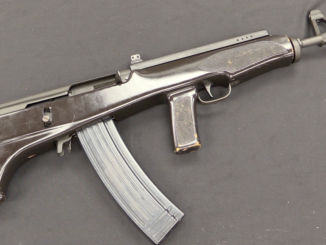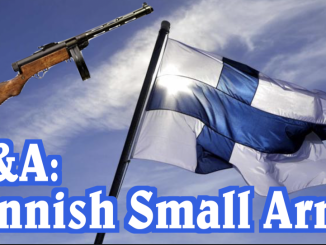In February of 1943, new production Suomi submachine guns began to include a 10-point compensator built into the barrel shroud. This pattern, really the only substantial variation in Finnish military m/31 production, was identified as the m/31 SJR, an abbreviation for muzzle brake (“suujarru“). Some earlier Suomis were modified to add the brake as well. Aimo Lahti was not a fan of the modification, and there were some complaints of snow packing to the device and freezing, causing a muzzle obstruction. So my question is, did the brake actually help make the gun more controllable? I took an opportunity at the range in Finland to try both types side by side to find out…
Also, the bonus nose-to-receiver-cap shooting technique!




Aimo Lahti personally disliked the muzzle break. From what i read, the weight of the gun combined with a long barrel and a already low powered cartridge made it unnecessary. By adding the muzzle break, the weight would increase even more.
He would also be worried about the possible decrease in velocity and reliability.
Muzzle brake (different) was used in L-39
https://www.rockislandauction.com/detail/71/1570/lahti-l39-antitank-gun-registered-destructive-device-wcase
L-39 apparently comes complete with cover for said device linked via chain
Surprised that such a long barrel was used on the Suomi? Has there ever been a description and justification for this? Maximum velocity and range I suspect, if you are predominantly using a 9mm in open country?
Is suspect maximum velocity. At the year of introduction, the smg concept was still really new. There was no standard.
You could have used 2 paper targets to show the difference. Dumb
“(…)were some complaints of snow packing to the device and freezing, causing a muzzle obstruction(…)”
This is ironic considering that https://www.jaegerplatoon.net/MACHINEPISTOLS1.htm claims that muzzle device was added specifically to prevent snow and debris ingress
During the war Finnish soldiers gave grateful feedback, but the feedback also revealed that Suomi submachine gun was not perfect. Tendency for recoil to cause muzzle climb still existed and was seen as largest remaining problem. When sudden spur of cases showing serious barrel corrosion spotted in January 1940 it was time believed to be result of snow and debris getting inside gun barrel, which caused necessity of finding a solution for this problem. The solution was to add a muzzle brake in the design. Only later on it was proved that the corrosion had been caused by use of wet ammunition.
For a 9×19 cartridge, a barrel longer than 10 inches does not make sense.
In fact, 8″ is plenty. By doubling the barrel length (from 8″ to 16″), the velocity of a 124gr bullet only increases by about 60 fps.
And regarding the fears of clogging the barrel with snow, they are completely untenable.
Suffice it to recall the practice of the Royal Navy, where to clean the muzzle of AA guns in the northern latitudes (from sea water frozen there), just the first two shots were fired with a practical blank.
Hold up….Let me fire these blanks at CQB distances then I’m in the game. Dumb.
You do not need such sharp self-criticism.
Being dumb is not against the law.
And, judging by the popularity of this state, it is even fashionable.
LOL
Love them soumi’s, I’ve got a soumi compensator from numrichs years ago for a project but never put it on , but I will say it ain’t that heavy when it’s in your hand , I’d rather have one on , keep them soumi’s coming Ian, thanks
I am not sure I will want to stick my nose on a metal cap in freezing finish winter. This looks a great way to burn your skin from the cold.